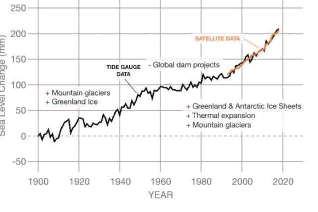Ahmedabad
(Head Office)Address : 506, 3rd EYE THREE (III), Opp. Induben Khakhrawala, Girish Cold Drink Cross Road, CG Road, Navrangpura, Ahmedabad, 380009.
Mobile : 8469231587 / 9586028957
Telephone : 079-40098991
E-mail: dics.upsc@gmail.com

Rising global sea surface temperature
Context:
• In February 2024, the average global sea surface temperature (SST) reached a record high of 21.06 degrees Celsius, marking the highest level since data collection began in 1979.
• Sea surface temperature refers to the temperature of the water at the ocean surface.
What are the reasons for rising SST?
Human Activities: Since the Industrial Revolution kicked off in the 19th Century, human activities such as burning fossil fuels have released high levels of greenhouse gases (GHGs) in the atmosphere.
• Greenhouse gases such as carbon dioxide, methane, ozone, and nitrous oxide trap heat in the atmosphere, leading to global warming.
• This phenomenon has resulted in the average global temperature rising by at least 1.2 degrees Celsius above pre-industrial levels.
Absorption by Oceans: Almost 90 percent of the extra heat trapped by GHGs has been absorbed by the oceans, making them steadily warmer over the decades.
El Niño: A weather pattern that refers to an abnormal warming of surface waters in the equatorial Pacific Ocean — has contributed to both ocean warming and rising global surface temperatures.
Weaker Winds: There is also less dust blowing off the Sahara Desert recently due to weaker-than-average winds.
Impact of Rising SST
Ocean Stratification: Warmer oceans lead to an increase in ocean stratification — the natural separation of an ocean’s water into horizontal layers by density, with warmer, lighter, less salty, and nutrient-poor water layering on top of heavier, colder, saltier, nutrient-rich water.
• Ocean ecosystems, typically influenced by currents, wind, and tides, rely on the mixing of water layers for stability.
• However, escalating temperatures have hindered the natural mixing process between these layers.
• As a consequence, the oceans capacity to absorb carbon dioxide from the atmosphere is diminished, and the oxygen absorbed struggles to distribute adequately into cooler ocean depths, posing a significant threat to marine life.
Threat to Phytoplanktons: Nutrients are not able to travel up to the surface of the oceans from below. This could threaten the population of phytoplankton — single-celled plants that thrive on the ocean surface and are the base of several marine food webs.
• Phytoplankton serve as a crucial food source for zooplankton, which in turn become prey for various marine organisms including crabs, fish, and sea stars.
• As a result, a decline in the phytoplankton population could lead to a collapse of marine ecosystems, disrupting the food chain and impacting various species dependent on it.
Marine Heat Waves: Warmer oceans cause marine heat waves (MHWs), which occur when the surface temperature of a particular region of the sea rises to 3 or 4 degrees Celsius above the average temperature for at least five days.
• According to the UN s Intergovernmental Panel on Climate Change (IPCC), heatwaves in the marine environment have doubled in frequency and intensified between 1982 and 2016.
• These marine heatwaves (MHWs) pose significant threats to marine ecosystems, leading to coral bleaching and disrupting the migration patterns of aquatic animals.
Increase in Intensity of Cyclones: Warmer temperatures lead to a higher rate of evaporation as well as the transfer of heat from the oceans to the air.
• As storms traverse warm oceans, they accumulate greater amounts of water vapor and heat, intensifying their strength.
• This increased energy leads to more powerful winds, heavier rainfall, and exacerbated flooding upon landfall, resulting in heightened devastation for human populations.
Way forward:
• In 2023, the concentration of GHG the highest levels ever recorded in the atmosphere.
• The only way to avoid or blunt the aforementioned consequences is to reduce GHG emissions.

Address : 506, 3rd EYE THREE (III), Opp. Induben Khakhrawala, Girish Cold Drink Cross Road, CG Road, Navrangpura, Ahmedabad, 380009.
Mobile : 8469231587 / 9586028957
Telephone : 079-40098991
E-mail: dics.upsc@gmail.com
Address: A-306, The Landmark, Urjanagar-1, Opp. Spicy Street, Kudasan – Por Road, Kudasan, Gandhinagar – 382421
Mobile : 9723832444 / 9723932444
E-mail: dics.gnagar@gmail.com
Address: 2nd Floor, 9 Shivali Society, L&T Circle, opp. Ratri Bazar, Karelibaugh, Vadodara, 390018
Mobile : 9725692037 / 9725692054
E-mail: dics.vadodara@gmail.com
Address: 403, Raj Victoria, Opp. Pal Walkway, Near Galaxy Circle, Pal, Surat-394510
Mobile : 8401031583 / 8401031587
E-mail: dics.surat@gmail.com
Address: 303,305 K 158 Complex Above Magson, Sindhubhavan Road Ahmedabad-380059
Mobile : 9974751177 / 8469231587
E-mail: dicssbr@gmail.com
Address: 57/17, 2nd Floor, Old Rajinder Nagar Market, Bada Bazaar Marg, Delhi-60
Mobile : 9104830862 / 9104830865
E-mail: dics.newdelhi@gmail.com